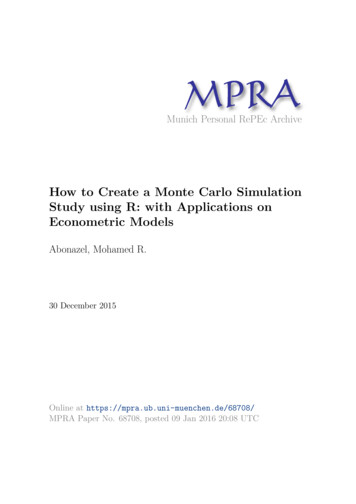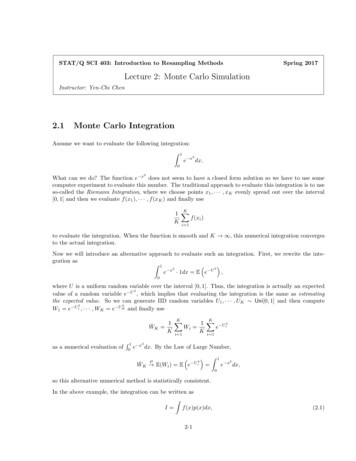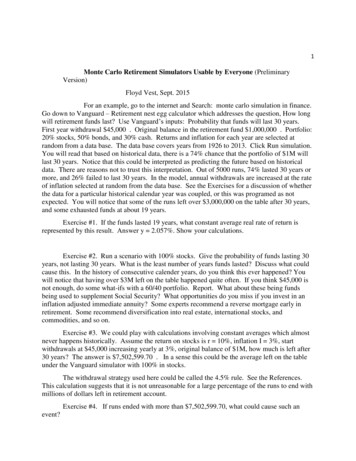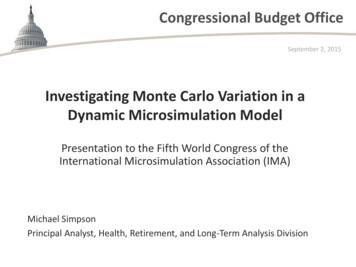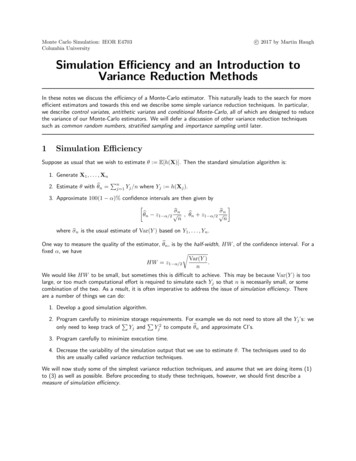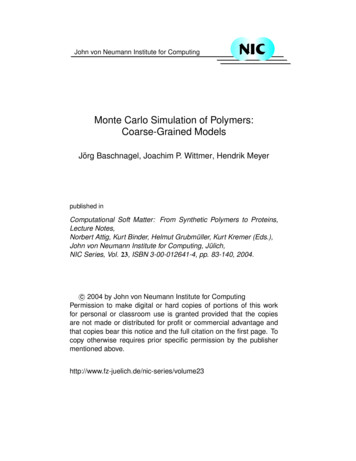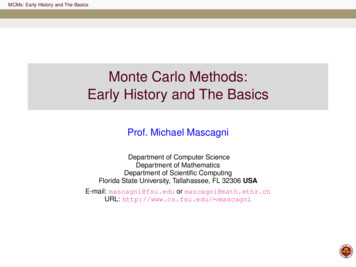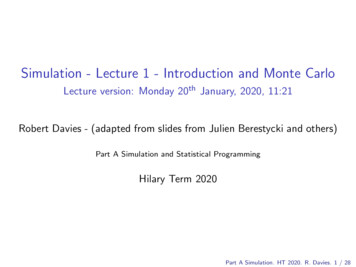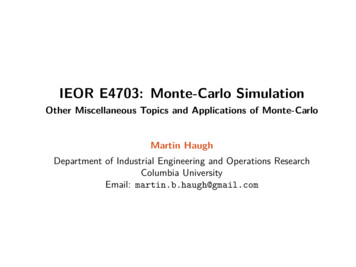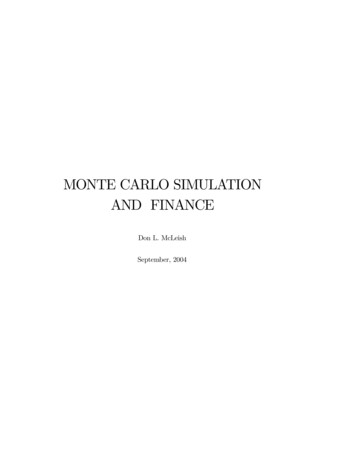
Transcription
MONTE CARLO SIMULATIONAND FINANCEDon L. McLeishSeptember, 2004
ii
Contents1 Introduction12 Some Basic Theory of Finance13Introduction to Pricing: Single Period Models . . . . . . . . . . . . . .13Multiperiod Models. . . . . . . . . . . . . . . . . . . . . . . . . . . . .21Determining the Process Bt . . . . . . . . . . . . . . . . . . . . . . . . .30Minimum Variance Portfolios and the Capital Asset Pricing Model. . .35Entropy: choosing a Q measure . . . . . . . . . . . . . . . . . . . . .56Models in Continuous Time . . . . . . . . . . . . . . . . . . . . . . . .67Problems . . . . . . . . . . . . . . . . . . . . . . . . . . . . . . . . . .923 Basic Monte Carlo Methods97. . . . . . . . . . . . . . . . . . . . . . . . . . . . . . . . . . . . . . .97Uniform Random Number Generation . . . . . . . . . . . . . . . . . .98Apparent Randomness of Pseudo-Random Number Generators . . . . 109Generating Random Numbers from Non-Uniform Continuous Distributions . . . . . . . . . . . . . . . . . . . . . . . . . . . . . . . . 116Generating Random Numbers from Discrete Distributions . . . . . . . 166Random Samples Associated with Markov Chains. . . . . . . . . . . 176Simulating Stochastic Partial Differential Equations. . . . . . . . . . . 186Problems . . . . . . . . . . . . . . . . . . . . . . . . . . . . . . . . . . 196iii
ivCONTENTS4 Variance Reduction Techniques203Introduction . . . . . . . . . . . . . . . . . . . . . . . . . . . . . . . . . 203Variance reduction for one-dimensional Monte-Carlo Integration. . . . 207Problems . . . . . . . . . . . . . . . . . . . . . . . . . . . . . . . . . . 2525 Simulating the Value of Options255Asian Options . . . . . . . . . . . . . . . . . . . . . . . . . . . . . . . . 255Pricing a Call option under stochastic interest rates. . . . . . . . . . . 266Simulating Barrier and lookback options . . . . . . . . . . . . . . . . . 269Survivorship Bias . . . . . . . . . . . . . . . . . . . . . . . . . . . . . . 290Problems . . . . . . . . . . . . . . . . . . . . . . . . . . . . . . . . . . 2986Quasi- Monte Carlo Multiple Integration301Introduction . . . . . . . . . . . . . . . . . . . . . . . . . . . . . . . . . 301Theory of Low discrepancy sequences . . . . . . . . . . . . . . . . . . 307Examples of low discrepancy sequences . . . . . . . . . . . . . . . . . . 310Problems . . . . . . . . . . . . . . . . . . . . . . . . . . . . . . . . . . 324
CONTENTSDedication:vto be addedAcknowledgement 1 I am grateful to all of the past students of Statistics 906and the Master’s of Finance program at the University of Waterloo for their patient reading and suggestions to improve this material, especially Keldon Drudgeand Hristo Sendov. I am also indebted to my colleagues, Adam Kolkiewicz andPhelim Boyle for their contributions to my understanding of this material.
Chapter 1IntroductionExperience, how much and of what, is a valuable commodity. It is a majordifference between an airline pilot and a New York Cab driver, a surgeon anda butcher, a succesful financeer and a cashier at your local grocers. Experiencewith data, with its analysis, experience constructing portfolios, trading, andeven experience losing money (one experience we all think we could do without)are all part of the education of the financially literate. Of course, few of ushave the courage to approach the manager of our local bank and ask for a fewmillion so we can acquire this experience, and fewer still managers have thecourage to acceed to our request. The “joy of simulation” is that you do notneed to have a Boeing 767 to fly one, and that you don’t need millions of dollarsto acquire a considerable experience valuing financial products, constructingportfolios and testing trading rules. Of course if your trading rule is to buycondos in Florida because you expect boomers to all wish to retire there, acomputer simulation will do little to help you since the ingredients to yourdecision are largely psychological (yours and theirs), but if it is that you shouldhedge your current investment in condos using financial derivatives real estatecompanies, then the methods of computer simulation become relevant.1
2CHAPTER 1. INTRODUCTIONThis book concerns the simulation and analysis of models for financial mar-kets, particularly traded assets like stocks, bonds. We pay particular attentionto financial derivatives such as options and futures. These are financial instruments which derive their value from some associated asset. For example a calloption is written on a particular stock, and its value depends on the price ofthe stock at expiry. But there are many other types of financial derivatives,traded on assets such as bonds, currency markets or foreign exchange markets,and commodities. Indeed there is a growing interest in so-called “real options”,those written on some real-world physical process such as the temperature orthe amount of rainfall.In general, an option gives the holder a right, not an obligation, to sell orbuy a prescribed asset (the underlying asset) at a price determined by thecontract (the exercise or strike price). For example if you own a call option onshares of IBMwith expiry date Oct. 20, 2000 and exercise price 120, thenon October 20, 2000 you have the right to purchase a fixed number , say 100shares of IBM at the price 120. If IBM is selling for 130 on that date, thenyour option is worth 10 per share on expiry. If IBM is selling for 120 or less,then your option is worthless. We need to know what a fair value would befor this option when it is sold, say on February 1, 2000. Determining this fairvalue relies on sophisticated models both for the movements in the underlyingasset and the relationship of this asset with the derivative, and is the subject ofa large part of this book. You may have bought an IBM option for two possiblereasons, either because you are speculating on an increase in the stock price,or to hedge a promise that you have made to deliver IBM stocks to someonein the future against possible increases in the stock price. The second use ofderivatives is similar to the use of an insurance policy against movements inan asset price that could damage or bankrupt the holder of a portfolio. It isthis second use of derivatives that has fueled most of the phenomenal growthin their trading. With the globalization of economies, industries are subject to
3more and more economic forces that they are unable to control but neverthelesswish some form of insurance against. This requires hedges against a wholelitany of disadvantageous moves of the market such as increases in the cost ofborrowing, decreases in the value of assets held, changes in a foreign currencyexchange rates, etc.The advanced theory of finance, like many areas where advanced mathematics plays an important part, is undergoing a revolution aided and abetted bythe computer and the proliferation of powerful simulation and symbolic mathematical tools. This is the mathematical equivalent of the invention of theprinting press. The numerical and computational power once reserved for themost highly trained mathematicians, scientists or engineers is now available toany competent programmer.One of the first hurdles faced before adopting stochastic or random models infinance is the recognition that for all practical purposes, the prices of equities inan efficient market are random variables, that is while they may show some dependence on fiscal and economic processes and policies, they have a componentof randomness that makes them unpredictable. This appears on the surface tobe contrary to the training we all receive that every effect has a cause, and everychange in the price of a stock must be driven by some factor in the company orthe economy. But we should remember that random models are often appliedto systems that are essentially causal when measuring and analyzing the various factors influencing the process and their effects is too monumental a task.Even in the simple toss of a fair coin, the result is predetermined by the forcesapplied to the coin during and after it is tossed. In spite of this, we model itas a random variable because we have insufficient information on these forcesto make a more accurate prediction of the outcome. Most financial processesin an advanced economy are of a similar nature. Exchange rates, interest ratesand equity prices are subject to the pressures of a large number of traders,government agencies, speculators, as well as the forces applied by international
4CHAPTER 1. INTRODUCTIONtrade and the flow of information. In the aggregate there is an extraordinarynumber of forces and information that influence the process. While we mighthope to predict some features of the process such as the average change in priceor the volatility, a precise estimate of the price of an asset one year from today is clearly impossible. This is the basic argument necessitating stochasticmodels in finance. Adoption of a stochastic model does neither implies thatthe process is pure noise nor that we are unable to forecast. Such a model isadopted whenever we acknowledge that a process is not perfectly predictableand the non-predictable component of the process is of sufficient importance towarrant modeling.Now if we accept that the price of a stock is a random variable, what arethe constants in our model? Is a dollar of constant value, and if so, the dollarof which nation? Or should we accept one unit of a index what in some senserepresents a share of the global economy as the constant? This question concernsour choice of what is called the “numeraire” in deference to the French influenceon the theory of probability, or the process against which the value of our assetswill be measured. We will see that there is not a unique answer to this question,nor does that matter for most purposes. We can use a bond denominated inCanadian dollars as the numeraire or one in US dollars. Provided we accountfor the variability in the exchange rate, the price of an asset will be the same.So to some extent our choice of numeraire is arbitrary- we may pick whateveris most convenient for the problem at hand.One of the most important modern tools for analyzing a stochastic systemis simulation. Simulation is the imitation of a real-world process or system. Itis essentially a model, often a mathematical model of a process. In finance,a basic model for the evolution of stock prices, interest rates, exchange ratesetc. would be necessary to determine a fair price of a derivative security.Simulations, like purely mathematical models, usually make assumptions aboutthe behaviour of the system being modelled. This model requires inputs, often
5called the parameters of the model and outputs a result which might measure theperformance of a system, the price of a given financial instrument, or the weightson a portfolio chosen to have some desirable property. We usually construct themodel in such a way that inputs are easily changed over a given set of values,as this allows for a more complete picture of the possible outcomes.Why use simulation? The simple answer is that is that it transfers workto the computer. Models can be handled which have greater complexity, andfewer assumptions, and a more faithful representation of the real-world thanthose that can be handled tractable by pure mathematical analysis are possible.By changing parameters we can examine interactions, and sensitivities of thesystem to various factors. Experimenters may either use a simulation to providea numerical answer to a question, assign a price to a given asset, identify optimalsettings for controllable parameters, examine the effect of exogenous variablesor identify which of several schemes is more efficient or more profitable.Thevariables that have the greatest effect on a system can be isolated. We canalso use simulation to verify the results obtained from an analytic solution.For example many of the tractable models used in finance to select portfoliosand price derivatives are wrong. They put too little weight on the extremeobservations, the large positive and negative movements (crashes), which havethe most dramatic effect on the results. Is this lack of fit of major concern whenwe use a standard model such as the Black-Scholes model to price a derivative?Questions such as this one can be answered in part by examining simulationswhich accord more closely with the real world, but which are intractable tomathematical analysis.Simulation is also used to answer questions starting with “what if”. Forexample, What would be the result if interest rates rose 3 percentage pointsover the next 12 months? In engineering, determining what would happen undermore extreme circumstances is often referred to as stress testing and simulationis a particularly valuable tool here since the scenarios we are concerned about are
6CHAPTER 1. INTRODUCTIONthose that we observe too rarely to have a substantial experience of. Simulationsare used, for example, to determine the effect of an aircraft of flying underextreme conditions and is used to analyse the flight data information in theevent of an accident. Simulation often provides experience at a lower cost thanthe alternatives.But these advantages are not without some sacrifice. Two individuals maychoose to model the same phenomenon in different ways, and as a result, mayhave quite different simulation results. Because the output from a simulationis random, it is sometimes harder to analyze- some statistical experience andtools are a valuable asset. Building models and writing simulation code is notalways easy. Time is required both to construct the simulation, validate it, andto analyze the results. And simulation does not render mathematical analysisunnecessary. If a reasonably simple analytic expression for a solution exists,it is always preferable to a simulation. While a simulation may provide anapproximate numerical answer at one or more possible parameter values, onlyan expression for the solution provides insight to the way in which it respondsto the individual parameters, the sensitivities of the solution.In constructing a simulation, you should be conscious of a number of distinctsteps;1. Formulate the problem at hand. Why do we need to use simulation?2. Set the objectives as specifically as possible. This should include whatmeasures on the process are of most interest.3. Suggest candidate models. Which of these are closest to the real-world?Which are fairly easy to write computer code for? What parameter valuesare of interest?4. If possible, collect real data and identify which of the above models ismost appropriate. Which does the best job of generating the general
7characteristics of the real data?5. Implement the model. Write computer code to run simulations.6. Verify (debug) the model. Using simple special cases, insure that the codeis doing what you think it is doing.7. Validate the model. Ensure that it generates data with the characteristicsof the real data.8. Determine simulation design parameters. How many simulations are tobe run and what alternatives are to be simulated?9. Run the simulation. Collect and analyse the output.10. Are there surprises? Do we need to change the model or the parameters?Do we need more runs?11. Finally we document the results and conclusions in the light of the simulation results. Tables of numbers are to be avoided. Well-chosen graphs areoften better ways of gleaning qualitative information from a simulation.In this book, we will not always follow our own advice, leaving some ofthe above steps for the reader to fill in. Nevertheless, the importance of modelvalidation, for example, cannot be overstated. Particularly in finance where datais often plentiful, highly complex mathematical models are too often appliedwithout any evidence that they fit the observed data adequately. The reader isadvised to consult and address the points in each of the steps above with eachnew simulation (and many of the examples in this text).ExampleLet us consider the following example illustrating a simple use for a simulation model. We are considering a buy-out bid for the shares of a company.Although the company’s stock is presently valued at around 11.50 per share,a careful analysis has determined that it fits sufficiently well with our current
8CHAPTER 1. INTRODUCTIONassets that if the buy-out were successful, it would be worth approximately 14.00 per share in our hands. We are considering only three alternatives,an immediate cash offer of 12.00, 13.00 or 14.00 per share for outstandingshares of the company. Naturally we would like to bid as little as possible, butwe expect a competitor to virtually simultaneously make a bid for the companyand the competitor values the shares differently. The competitor has three bidding strategies that we will simply identify as I, II, and III. There are costsassociated with any pair of strategies (our bid-competitor’s bidding strategy)including costs associated with losing a given bid to the competitor or payingtoo much for the company. In other words, the payoff to our firm depends onthe amount bid by the competitor and the possible scenarios are as given inthe following 131-44140-55The payoffs to the competitor are somewhat different and given 4-61405-5For example, the combination of your bid 13 per share and your competitor’s strategy II results in a loss of 4 units (for example four dollars pershare) to you and a gain of 4 units to your competitor. However it is not alwaysthe case that the your loss is the same as your competitor’s gain. A game withthis property is called a zero-sum game and these are much easier to analyzeanalytically. Define the 3 3 matrix of payoffs to your company by A and the
9payoff matrix to your competitor by B, 3 2-2-1 A 1 -4 4 , B 0 0 -5 50-2453 -6 . -5Provided that you play strategy i 1, 2, 3 (i.e. bid 12, 13, 14 with proba-bilities p1 , p2 , p3 respectively and the probabilities of the competitor’s strategiesare q1 , q2 , q3 . Then if we denote p 1 p p2 p3 q1 , and q q2 q3we can write the expected payoff to you in the form , P3i 1P3j 1pi Aij qj . Whenwritten as a vector-matrix product, this takes the form pT Aq. This might bethought of as the average return to your firm in the long run if this game wererepeated many times, although in the real world, the game is played only once.If the vector q were known to you, you would clearly choose pi 1 for therow i corresponding to the maximum component of Aq since this maximizesyour payoff. Similarly if your competitor knew p, they would choose qj 1for the column j corresponding to the maximum component of pT B. Overthe long haul, if this game were indeed repeated may times, you would likelykeep track of your opponent’s frequencies and replace the unknown probabilitiesby the frequencies. However, we assume that both the actual move made byyour opponent and the probabilities that they use in selecting their move areunknown to you at the time you commit to your strategy. However, if the gameis repeated many times, each player obtains information about their opponent’staste in moves, and this would seem to be a reasonable approach to building asimulation model for this game. Suppose the game is played repeatedly, witheach of the two players updating their estimated probabilities using informationgathered about their opponent’s historical use of their available strategies. We
10CHAPTER 1. INTRODUCTIONmay record number of times each strategy is used by each player and hope thatthe relative frequencies approach a sensible limit. This is carried out by thefollowing Matlab function;function [p,q] nonzerosum(A,B,nsim)% A and B are payoff matrices to the two participants in a game.Outputs%mixed strategies p and q determined by simulation conducted nsimtimesn size(A);% A and B havethe same sizep ones(1,n(1)); q ones(n(2),1); % initialize with positive weightson all strategiesfor i 1:nsim% runs the simulation nsim times[m,s] max(A*q);% s index of optimal strategy for[m,t] max(p*B);% index of optimal strategy foruscompetitorp(s) p(s) 1;% augment counts for usq(t) q(t) 1;% augment counts for competitorendp p-ones(1,n(1)); p p/sum(p);%remove initial weights from countsand thenq q-ones(n(2),1); q q/sum(q);% convert counts to relative frequenciesThe following output results from running this function for 50,000 simulations.[p,q] nonzerosum(A,B,50000)This results in approximately p0 [ 23 0 13 ]and q 0 [01212]with anaverage payoff to us of 0 and to the competitor 1/3. This seems to indicate thatthe strategies should be “mixed” or random. You should choose a bid of 12.00with probability around 2/3, and 14.00 with probability 1/3. It appears that
11the competitor need only toss a fair coin and select between B and C based onits outcome. Why randomize your choice? The average value of the game toyou is 0if you use the probabilities above (in fact if your competitor choosesprobabilities q 0 [01212]it doesn’t matter what your frequencies are, youraverage is 0). If you were to believe a single fixed strategy is always your “best”then your competitor could presumably determine what your “best” strategy isand act to reduce your return (i.e. substantially less than 0) while increasingtheirs. Only randomization provides the necessary insurance that neither playercan guess the strategy to be employed by the other. This is a rather simpleexample of a two-person game with non-constant sum (in the sense that A Bis not a constant matrix). Mathematical analysis of such games can be quitecomplex. In such case, provided we can ensure cooperation, participants maycooperate for a greater total return.There is no assurance that the solution above is optimal. In fact the abovesolution is worth an average of 0 per game to us and 1/3 to our competitor.If we revise our strategy to p0 [ 232 19 9 ],for example, our average return isstill 0 but we have succeeded in reducing that of our opponent to 1/9. Thesolution we arrived at in this case seems to be sensible solution, achieved withlittle effort. Evidently, in a game such as this, there is no clear definition ofwhat an optimal strategy would be, since one might plan one’s play based onthe worst case, or the best case scenario, or something in between such as anaverage? Do you attempt to collaborate with your competitor for greater totalreturn and then subsequently divide this in some fashion? This simulation hasemulated a simple form of competitor behaviour and arrived at a reasonablesolution, the best we can hope for without further assumptions.There remains the question of how we actually select a bid with probabilities2/3, 0 and 1/3 respectively. First let us assume that we are able to choose a“random number” U in the interval [0,1] so that the probability that it fallsin any given subinterval is proportional to the length of that subinterval. This
12CHAPTER 1. INTRODUCTIONmeans that the random number has a uniform distribution on the interval [0,1].Then we could determine our bid based on the value of this random numberfrom the following table;IfU 2/3Bid122/3 · U 11314The way in which U is generated on a computer will be discussed in moredetail in chapter 2, but for the present note that each of the three alternativebids have the correct probabilities.
Chapter 2Some Basic Theory ofFinanceIntroduction to Pricing: Single Period ModelsLet us begin with a very simple example designed to illustrate the no-arbitrageapproach to pricing derivatives. Consider a stock whose price at present is s.Over a given period, the stock may move either up or down, up to a value suwhere u 1 with probability p or down to the value sd where d 1 withprobability 1 p. In this model, these are the only moves possible for the stockin a single period. Over a longer period, of course, many other values arepossible. In this market, we also assume that there is a so-called risk-free bondavailable returning a guaranteed rate of r% per period. Such a bond cannotdefault; there is no random mechanism governing its return which is knownupon purchase. An investment of 1 at the beginning of the period returns aguaranteed (1 r) at the end. Then a portfolio purchased at the beginningof a period consisting of y stocks and x bonds will return at the end of theperiod an amount x(1 r) ysZwhere Z is a random variable taking13
14CHAPTER 2. SOME BASIC THEORY OF FINANCEvalues u or d with probabilities p and 1 p respectively. We permit owninga negative amount of a stock or bond, corresponding to shorting or borrowingthe correspond asset for immediate sale.An ambitious investor might seek a portfolio whose initial cost is zero (i.e.x ys 0) such that the return is greater than or equal to zero with positiveprobability. Such a strategy is called an arbitrage. This means that the investoris able to achieve a positive probability of future profits with no down-side riskwith a net investment of 0. In mathematical terms, the investor seeks a point(x, y) such that x ys 0 (net cost of the portfolio is zero) andx(1 r) ysu 0,x(1 r) ysd 0with at least one of the two inequalities strict (so there is never a loss and anon-zero chance of a positive return). Alternatively, is there a point on the liney 1s x which lies above both of the two lines1 rxsu1 rxy sdy and strictly above one of them? Since all three lines pass through the origin,we need only compare the slopes; an arbitrage will NOT be possible if 1 r11 r· · sdssu(2.1)and otherwise there is a point (x, y) permitting an arbitrage. The condition forno arbitrage (2.1) reduces toud 1 1 r1 r(2.2)So the condition for no arbitrage demands that (1 r u) and (1 r d)have opposite sign or d · (1 r) · u.Unless this occurs, the stock alwayshas either better or worse returns than the bond, which makes no sense in a
INTRODUCTION TO PRICING: SINGLE PERIOD MODELS15free market where both are traded without compulsion. Under a no arbitrageassumption since d · (1 r) · u, the bond payoff is a convex combination ora weighted average of the two possible stock payoffs; i.e. there are probabilities0 · q · 1 and (1 q) such that (1 r) qu (1 q)d. In fact it is easy tosolve this equation to determine the values of q and 1 q.q (1 r) d,u dand 1 q u (1 r).u dDenote by Q the probability distribution which puts probabilities q and 1 qon these points su, sd. Then if S1 is the value of the stock at the end of theperiod, note that111EQ (S1 ) (qsu (1 q)sd) s(1 r) s1 r1 r1 rwhere EQ denotes the expectation assuming that Q describes the probabilitiesof the two outcomes.In other words, if there is to be no arbitrage, there exists a probability measure Q such that the expected price of future value of the stock S1discountedto the present using the return from a risk-free bond is exactly the present valueof the stock. The measure Q is called the risk-neutral measure and the probabilities that it assigns to the possible outcomes of S are not necessarily thosethat determine the future behaviour of the stock. The risk neutral measureembodies both the current consensus beliefs in the future value of the stock andthe consensus investors’ attitude to risk avoidance. It is not usually true that11 r EP (S1 ) s with P denoting the actual probability distribution describingthe future probabilities of the stock. Indeed it is highly unlikely that an investorwould wish to purchase a risky stock if he or she could achieve exactly the sameexpected return with no risk at all using a bond. We generally expect thatto make a risky investment attractive, its expected return should be greaterthan that of a risk-free investment. Notice in this example that the risk-neutralmeasure Q did not use the probabilities p, and 1 p that the stock would go
16CHAPTER 2. SOME BASIC THEORY OF FINANCEup or down and this seems contrary to intuition. Surely if a stock is more likelyto go up, then a call option on the stock should be valued higher!Let us suppose for example that we have a friend willing, in a private transaction with me, to buy or sell a stock at a price determined from his subjectivelyassigned distribution P , different from Q. The friend believes that the stockis presently worthpsu (1 p)sd1EP S1 6 s since p 6 q.1 r1 rSuch a friend offers their assets as a sacrifice to the gods of arbitrage. If thefriend’s assessed price is greater than the current market price, we can buy onthe open market and sell to the friend. Otherwise, one can do the reverse.Either way one is enriched monetarily (and perhaps impoverished socially)!So why should we use the Q measure to determine the price of a given assetin a market (assuming, of course, there is a risk-neutral Q measure and we areable to determine it)? Not because it precisely describes the future behaviourof the stock, but because if we use any other distribution, we offer an intelligentinvestor (there are many!) an arbitrage opportunity, or an opportunity to makemoney at no risk and at our expense.Derivatives are investments which derive their value from that of a corresponding asset, such as a stock.A European call option is an option whichpermits you (but does not compel you) to purchase the stock at a fixed futuredate ( the maturity date) or for a given predetermined price, the exercise priceof the option). For example a call option with exercise price 10 on a stockwhose future value is denoted S1 , is worth on expiry S1 10 if S1 10 butnothing at all if S1 10. The difference S1 10 between the value of the stockon expiry and the exercise price of the option is your profit if you exercises theoption, purchasing the stock for 10 and sell it on the open market at S1 .However, if S1 10, there is no point in exercising your option as you arenot compell
MONTE CARLO SIMULATION AND FINANCE Don L. McLeish September, 2004. ii. Contents 1 Introduction 1 2 Some Basic Theory of Finance 13 . Variance reduction for one-dimensional Monte-Carlo Integration. . . . 207 Problems .252 5 Simulating the Value of Options 255 AsianOptions.255 Pricing a Call option under stochastic interest rates .
